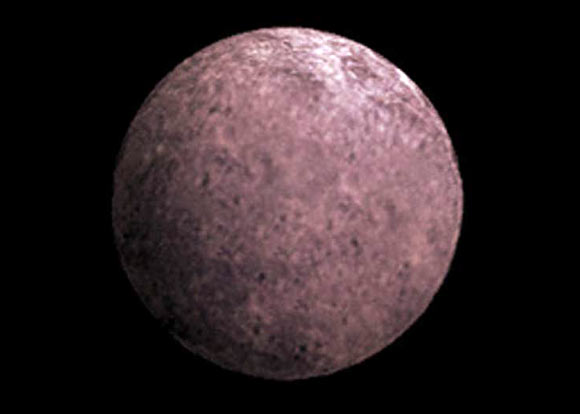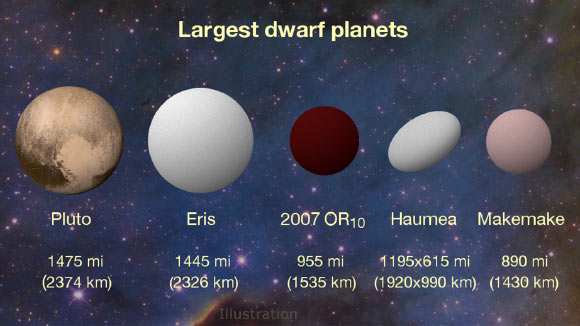According to observations from ESA’s Herschel Space Observatory and NASA’s Kepler Space Telescope-K2 extended mission, the dwarf planet and trans-Neptunian object (225088) 2007 OR10 is the largest unnamed object in our Solar System and the third largest of a huge population of dwarf planets.

Artist’s impression of the dwarf planet and trans-Neptunian object (225088) 2007 OR10. Image credit: NASA.
(225088) 2007 OR10, nicknamed ‘Snow White,’ was discovered in July 2007, by a team of astronomers from the California Institute of Technology who were using the Samuel Oschin Telescope at Palomar Observatory.
Previous estimates suggested a diameter of 795 miles (1,280 km) for this dwarf planet. However, without a handle on the object’s rotation period, those studies were limited in their ability to estimate its overall brightness, and hence its size.
The discovery of the very slow rotation by NASA’s K2 mission was essential for scientists to construct more detailed models that revealed the peculiarities of the object.
Together, the two telescopes allowed a team of astronomers from Australia and Europe to measure the fraction of sunlight reflected by (225088) 2007 OR10, and the fraction absorbed and later radiated back as heat.
Putting these two data sets together provided an unambiguous estimation of the dwarf planet’s size and how reflective it is.
According to the new measurements, the diameter of (225088) 2007 OR10 is 955 miles (1,535 km) — 160 miles (255 km) larger than previously thought and about 60 miles (100 km) greater than the next largest dwarf planet, Makemake.
Another dwarf planet, Haumea, has an oblong shape that is wider on its long axis than (225088) 2007 OR10, but its overall volume is smaller.

New results peg (225088) 2007 OR10 as the largest unnamed body in our Solar System. Image credit: Konkoly Observatory / András Pál, Hungarian Astronomical Association / Iván Éder, NASA / JHUAPL / SwRI.
“Our revised larger size for 2007 OR10 makes it increasingly likely the planet is covered in volatile ices of methane, carbon monoxide and nitrogen, which would be easily lost to space by a smaller object,” explained Dr. András Pál, an astronomer with Konkoly Observatory in Budapest, Hungary, and lead author of the new findings appearing in the Astronomical Journal (arXiv.org preprint).
“It’s thrilling to tease out details like this about a distant, new world — especially since it has such an exceptionally dark and reddish surface for its size.”
The larger size of (225088) 2007 OR10 also implies higher gravity and a very dark surface — the latter because the same amount of light is being reflected by a larger body.
This dark nature is different from most dwarf planets, which are much brighter.
Previous ground-based observations found 2007 OR10 has a characteristic red color, and other researchers have suggested this might be due to methane ices on its surface.
As for when (225088) 2007 OR10 will finally get a name, that honor belongs to the dwarf planet’s discoverers — Meg Schwamb, Mike Brown and David Rabinowitz.
“The names of Pluto-sized bodies each tell a story about the characteristics of their respective objects. In the past, we haven’t known enough about (225088) 2007 OR10 to give it a name that would do it justice,” Schwamb said.
“I think we’re coming to a point where we can give (225088) 2007 OR10 its rightful name.”
_____
András Pál et al. 2016. Large size and slow rotation of the trans-Neptunian object (225088) 2007 OR10 discovered from Herschel and K2 observations. Astronomical Journal 151, 117; doi: 10.3847/0004-6256/151/5/117







